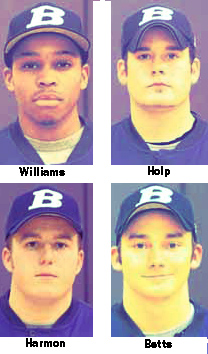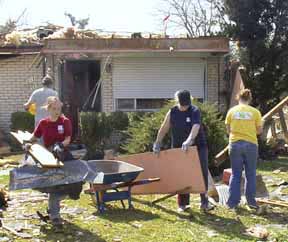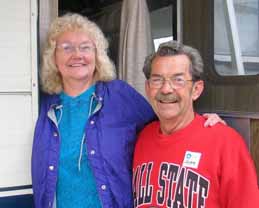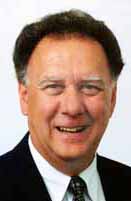Canadian Mennonite
Volume 11, No. 06
March 19, 2007

Five Bluffton ball players die in Atlanta bus crash
Bluffton, Ohio
 |
In the chaos and terror of the moments after the March 2 pre-dawn crash in Atlanta, Ga., members of the Bluffton University baseball team actually tried to lift their toppled bus from the shattered bodies of their teammates.
“We had guys stuck under the bus—legs, arms—and we had guys trying to pick the bus up,” shortstop Ryan Baightel, 21, told the Toledo Blade newspaper. “You are not going to pick a bus up, but yet they were still trying to pick the bus up.”
The crash occurred around 5:30 a.m., when a chartered bus carrying the Bluffton Beavers men’s baseball team plunged 10 metres from an overpass onto Interstate 75 near downtown Atlanta. The team was on its way to play Eastern Mennonite University in Sarasota, Fla., before playing in a spring break tournament in Gainesville, Fla.
Killed at the scene were Bluffton players Tyler Williams, 19, of Lima, Ohio; Cody Holp, 19, of Arcanum, Ohio; David Betts, 20, of Bryan, Ohio, a member of Zion Mennonite Church in Archbold, Ohio; and Scott Harmon, 19, of Lima; and bus driver Jerome Niemeyer, 65, of Columbus Grove, Ohio, and his wife, Jean, 61. Zachary Arend of Oakwood, Ohio, died in hospital a week after the crash.
Nearly a dozen of the 35 people on the bus were seriously injured in the crash, including Bluffton coach James Grandey, 29, who underwent facial surgery.
The bus had left Bluffton the previous night. Authorities said the charter, operated by Executive Coach Luxury Travel in Ottawa, Ohio, plunged from the overpass after the driver apparently mistook an exit ramp for a regular lane.
In the predawn darkness, the bus, travelling nearly 100 kph, collided with a metre-high concrete barrier and tore through a fence before hitting the interstate 10 metres below.
The bus came to rest on the driver’s side, spilling diesel fuel and scattering luggage and sports equipment.
Injured Bluffton player A.J. Ramthun described the scene after the crash: “With [eight centimetres] of diesel fuel running off onto the highway…they were...trying to lift the bus off of them.”
As news of the crash spread and the injured were taken to several Atlanta medical centres, members of the Atlanta Mennonite community began to respond.
At Grady Memorial Hospital, chaplain Susan Gascho, a former pastor at Atlanta Mennonite Fellowship, worked intensively with the crash survivors and their families.
On March 4, some of the Bluffton players and families of the crash victims returned to Ohio aboard a free AirTran flight, where a tearful welcome awaited them at Toledo’s Express Airport. Also on the plane were caskets carrying the bodies of Betts and Williams, as well as several members of Betts’ family.
“We’re coming home, and he’s coming home,” Betts’ sister Sarah, 23, told the Toledo newspaper.
Bluffton president James Harder also was on the flight. On March 2, Harder spoke during a nationally televised news conference held at Bluffton’s Founders Hall before leaving for Atlanta.
At the airport March 4, Harder said, “We were sending a baseball team to a spring break training exercise and tournament. They didn’t make it, but as I reflected on that, I think [the survivors] came together as a team in ways we couldn’t have imagined going down there. They became better individuals because of that.”
Harder said the Bluffton community would have much to deal with when classes were to resume on March 12 after spring break.
“So far we’ve just been dealing with the human tragedy,” Harder said. “We have a lot of healing to do.”
In Atlanta, Bluffton campus pastor Stephen “Tig” Intagliata spent the night of March 4 in a hospital where he was keeping watch with families of some of the crash victims.
Intagliata said six who were on the bus were still hospitalized with varying degrees of injury. “We’ve been back and forth to the different hospitals, just being there for the families,” Intagliata said the next day. “They’re being surrounded by offers of help, food, gifts, clothing.”
Intagliata said he had been working with Atlanta churches and other groups to keep a steady source of counselling, assistance, lodging and other resources available to the families of the injured in the weeks to come.
A fund has been established at Bluffton’s Citizens National Bank to help the baseball players involved in the crash and their families. A memorial service at Bluffton was planned for March 6.
Second wind: Tornado strikes while students on hurricane clean-up
New Orleans, La.
 |
Just days after returning from New Orleans, La., where they went to help people still affected by 2005’s Hurricane Katrina, 14 Canadian Mennonite University (CMU) students are trying to adjust to life back in Winnipeg.
“I’m still trying to process the experience,” says Mikaela Villalobos, a first-year youth ministry major from Quarryville, Pa. “You could sense the distress that the people of New Orleans were feeling, but that they were searching for hope.”
The distress Villalobos refers to is the result of a tornado that struck New Orleans in the early morning hours of Feb. 13. Although not large, it killed one person and injured others, while damaging dozens of businesses and homes all over the city.
The students had gone to New Orleans during their reading week with Mennonite Disaster Service (MDS) to rebuild homes damaged by Katrina. They started the week working on flood-damaged homes—painting, putting in floors and demolishing homes and garages that were beyond repair.
But after the tornado struck, they were pulled off their original work assignments to clean up debris.
“It’s kind of weird to be in [disaster] areas right after they’re hit,” says Andrew Richert, a 20-year-old church ministries major from Swift Current, Sask., who was among a group of students sent to the scene of the disaster shortly after the tornado touched down. “You see it on TV at home and you think, ‘Well, that’s too bad,’ and then you go have supper. But actually being there makes it that much more real.”
Before the week was out, all of the students had participated in some form of tornado clean-up, picking up debris, demolishing damaged properties, putting tarps over damaged roofs to prevent secondary damage, and helping residents move their belongings out of damaged homes.
Tales abounded of Katrina victims who had just returned to their homes, only to have them destroyed by the tornado. One passerby remarked that perhaps the destruction caused by the two disasters was “karma” for something someone in the city had done, and proceeded to apologize on behalf of that person.
Another tornado victim was quoted in The Times-Picayune, New Orleans’ daily newspaper, as saying that the help of CMU students was the only bright spot in her day.
But it was hearing the stories of people affected by the disasters that really affected the students.
“Everyone has a story,” says Aisha Entz, a first-year student from Burkina Faso. “Being able to hear the stories of people down there is something that really sticks out for me…. I think it impacted a lot of us, including the way we live our daily life.”
Richert agreed, saying it was an experience he won’t soon forget. “At one point, we were doing a roofing job in a section of town that was abandoned, with all of the houses gutted. I looked around and thought, wow, no one’s living there. You realize the impact of the storm. You realize you’re doing some good, and you’re glad you came.”
Many of the students are interested in serving with MDS again, but right now they’re just trying to adjust back to life in Winnipeg.
“The trip was a huge blessing, but I’m having a hard time coming back and getting into the swing of things,” says Villalobos. “We live in the wealthy side of town [at CMU], and after coming back from a place where people don’t have everything together yet…it’s hard.”
First-time RV couple loves the new MDS program
Neuanlage, Sask.
 |
John Braun did not have a recreational vehicle (RV) and he did not want one. He wasn’t interested. But he started looking for just such a vehicle after he picked up a leaflet at Neuanlage Grace Mennonite Church in Saskatchewan, where he and his wife Linda attend.
The leaflet described the new Mennonite Disaster Service (MDS) RV program, especially designed for seniors with RVs who want to serve but want a shorter work week. Having renewed energy after bouncing back from a heart attack and quadruple bypass surgery, he liked the sound of the program.
So the couple found a deal on a “classic” 1975 Itasca RV. John took it for a test drive 100 kilometres down the highway and said, “Let’s go!”
Well not quite that quickly. They applied and were accepted into the RV program through the Winnipeg MDS office. They also talked it over with their church. The congregation was very enthusiastic, offering their prayers and financial support.
“That church is so generous. It’s just amazing,” enthused Linda of the $2,000 raised by the congregation for the purchase of a table saw, chop saw, extension cords, air hose, compressor, roofing nailer, shovels, brooms and other equipment and supplies.
The Brauns left Saskatchewan just before New Year’s, arriving in Chunchula, Ala., on Jan. 4 after running into a blizzard after they crossed the border. During their time there, John worked on drywall and insulation installation, as well as painting doors and trim. The MDS women volunteers helped clean the church conference centre for a Bible conference, since local church members have jobs and can’t take time out to do the cleaning.
The appreciation of homeowners is overwhelming, the Brauns reported. “They can’t say enough; they are falling all over us with thanks.”
Of their RV experience, John said, “It’s awesome. The 1975 Itasca is small and [we] would rather have a bigger unit, but it’s been great.”
“The RV program is a wonderful idea,” John said. “It is a great way to get away from the cold winter in Canada.”
First lady lauds MEDA at malaria roundtable
Washington, D.C.
 |
It was likely the first time Mennonite Economic Development Associates (MEDA) was ever mentioned by an American first lady and “it sent chills up my spine,” said Allon Lefever.
Vice-chair of the MEDA board, Lefever was one of five panelists invited to share “best practices” at a White House conference last month on controlling malaria in Africa. He had just returned from Tanzania, where MEDA distributes insecticide-treated bed nets to pregnant women and infants.
Laura Bush addressed the meeting to encourage wider cooperation among faith-based, business and government efforts to combat malaria, the largest single killer of African children. She referred to the President’s Malaria Initiative (PMI), a five-year $1.2 billion US program to combat malaria in 15 of the hardest-hit African nations, which was launched by her husband George W. Bush in June 2005.
MEDA devised and manages a Tanzanian government program that uses commercial channels to make bed nets available throughout the country. New U.S. funding has enabled MEDA to expand the program to include young children.
Bush cited MEDA’s program as an example of public-private coordination. “In Tanzania,” she said, “the government’s malaria program subsidizes bed net vouchers for pregnant women. Now through a partnership between PMI and [MEDA], the programs will be expanded to cover all of Tanzania’s children.”
Since this part of the program was launched in late November, nets have been supplied to nearly 390,000 infants. The program will reach an additional 1.5 million babies every year.
“I was thrilled that this reference to MEDA’s program was part of her speech, especially in front of all those other NGO and government policy personnel attendees,” said Lefever, director of the MBA program at Eastern Mennonite University in Harrisonburg, Va.
In her remarks, Bush also said, “In many African villages, churches are the only formal institutions that can manage malaria control and prevention. In malaria-prone regions, people look first to their churches, mosques or synagogues for help.”
Bush cited a recent Gallup survey that asked citizens of 18 African nations which social or political organization they trust the most. “Overwhelmingly, people reported the greatest confidence in their religious institutions,” she said.